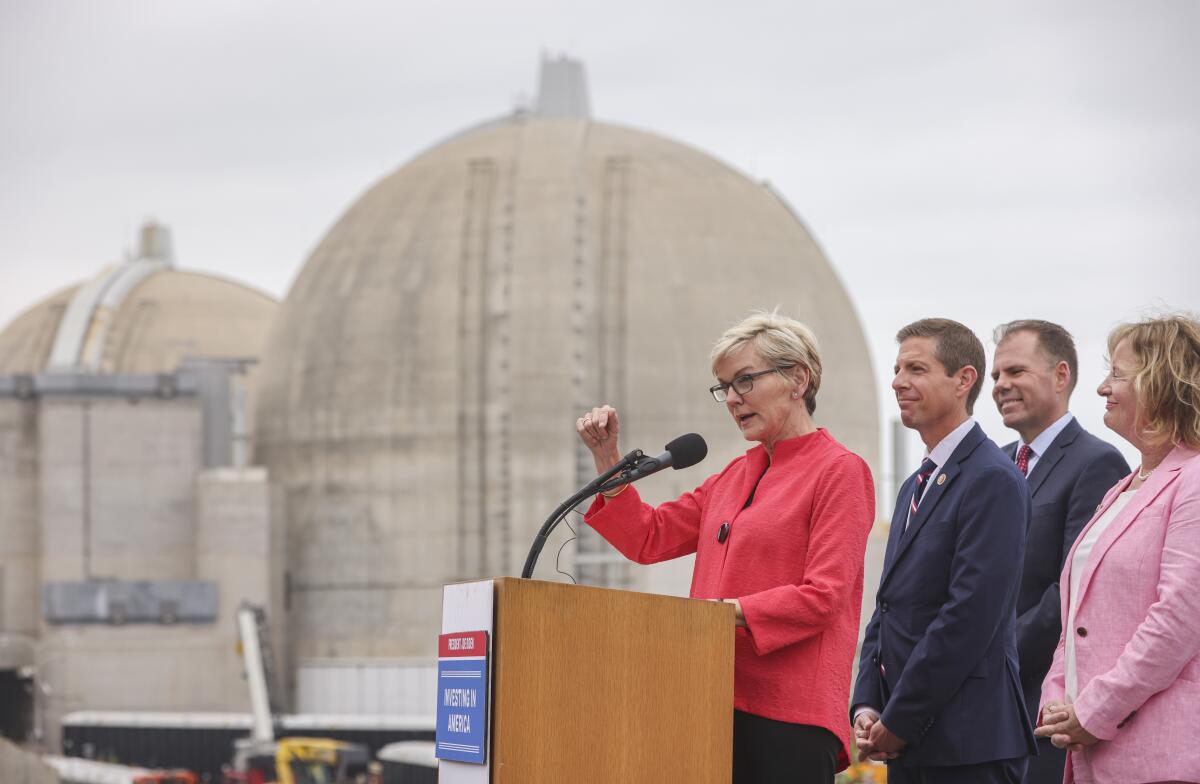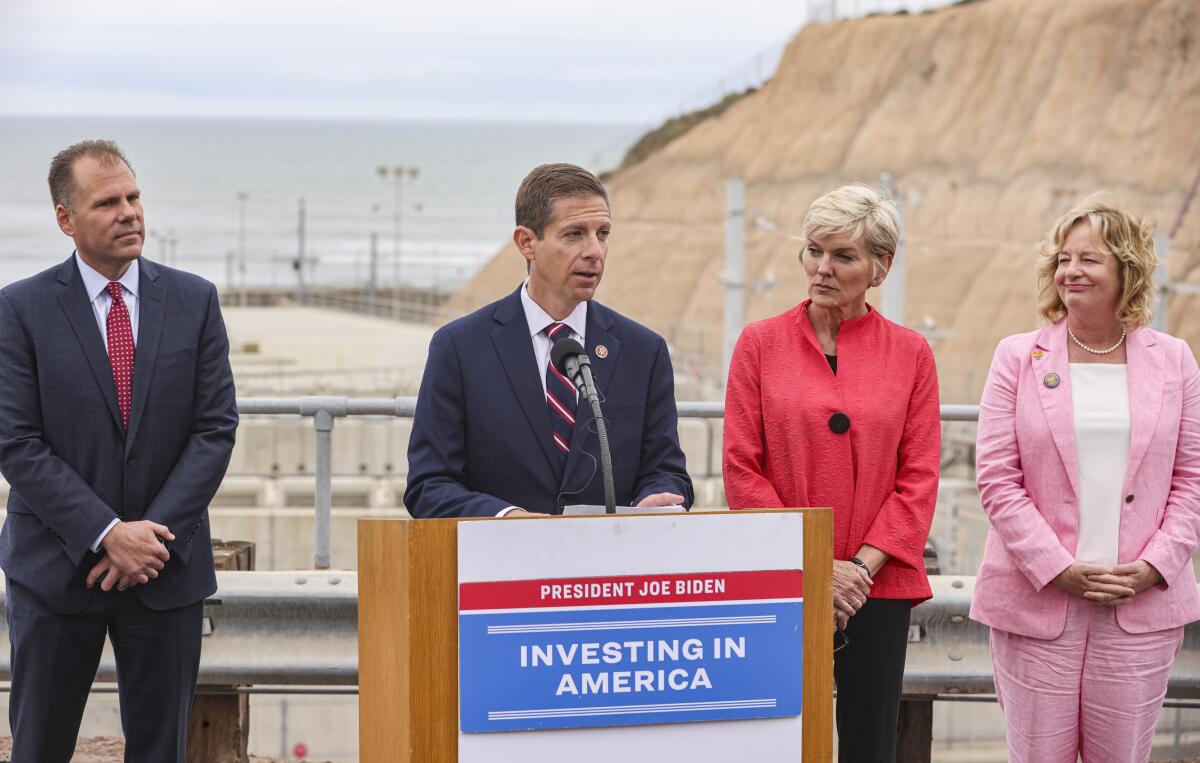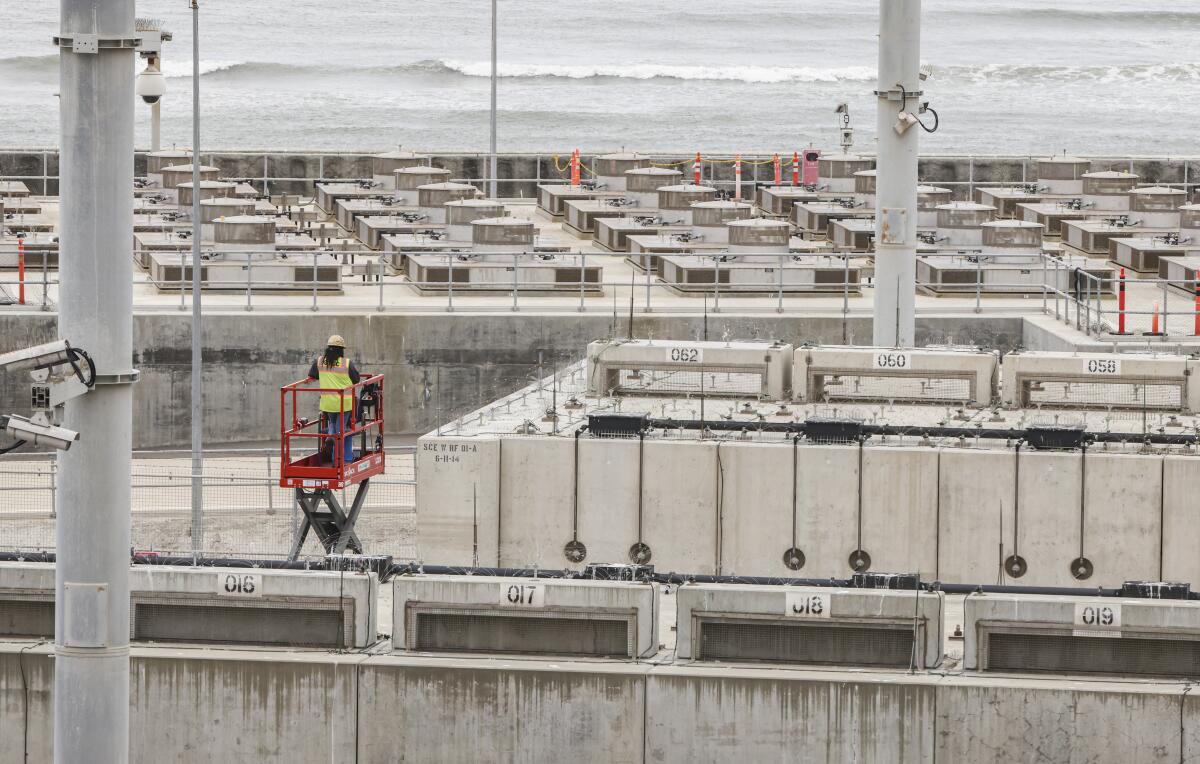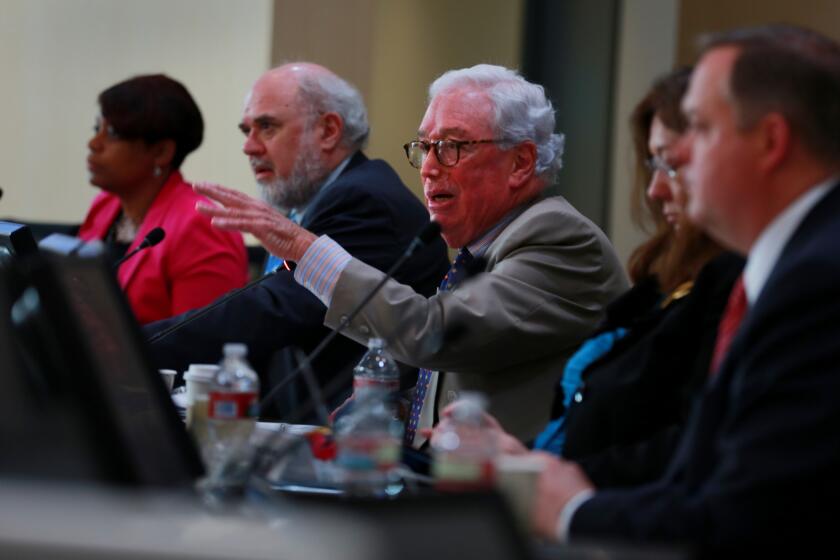Feds launch search for communities willing to take nuclear waste from San Onofre and other plants

- Share via
With the San Onofre Nuclear Generating Station as a backdrop, U.S. Energy Secretary Jennifer Granholm on Friday announced the Biden administration will spend $26 million in what figures to be one of many steps aimed at solving a decades-long problem: where to store the nuclear waste that has stacked up at commercial power plants across the country.
Saying “we all have to figure out the solution” to the waste issue, Granholm said a national search will be launched to find communities willing to take spent fuel rods from sites such as San Onofre on an interim basis until the federal government finds a permanent repository.
The 3.55 million pounds of radioactive spent fuel stored at the closed San Onofre nuclear power plant has long been a source of anxiety for some Southern Californians, who pass the iconic twin domes as they drive along Interstate 5. More than 9 million people live within 50 miles of the plant.
Some 73 canisters loaded with spent fuel assemblies have been lowered into vertical cavities at a storage site on the north end of the plant, behind a seawall a little more than 100 feet from the Pacific Ocean. An additional 50 canisters of waste rest horizontally nearby.
To identify potential sites, the Energy Department will fund 13 groups from different areas of the country to engage, set up workshops and elicit feedback from communities that may be interested in building interim facilities. The 13 groups — partnerships with universities, industry and nonprofits — will receive about $2 million each.
State officials say the winter’s wild weather helped refill hydropower generators, decreasing the risk of dangerous electricity outages this summer.
“Some communities don’t know what it means,” Granholm said. “They might be in, they might be out, but the bottom line is we have to form trust and be able to educate them and work with them on what their concerns are.”
Eventually, the Energy Department and the Biden administration want to find one to three communities for what the nuclear industry calls “consolidated interim storage” facilities.
According to a report released in April, the Energy Department estimates the entire process of identifying, screening, selecting and then building an interim storage site will take 10 to 15 years.
“In this phase, we’re beginning the conversation,” said Kathryn Huff, assistant secretary for the Office of Nuclear Energy at the Energy Department.

Rep. Mike Levin (D-San Juan Capistrano) accompanied Granholm on a tour of the San Onofre Nuclear Generating Station, known as SONGS.
“We finally have a plan when it comes to spent nuclear fuel across the United States,” Levin said. “Now we’ve got to execute on that plan.”
Under the Nuclear Waste Policy Act of 1982, the federal government has a legal responsibility to dispose of the roughly 89,000 metric tons of waste that has accumulated at nuclear power plants in 35 states.
A giant underground permanent repository was near completion at Yucca Mountain in southern Nevada, but in 2010, the Obama administration halted the project, after years of opposition from Silver State lawmakers, including former Senate Majority Leader Harry Reid.
With Yucca off the table, focus has shifted to finding interim facilities.
And if you care about the climate crisis, you should be paying attention.
To avoid a repeat of Yucca, the Energy Department is now taking a “consent-based” approach to find communities that may be open to building a storage facility because of the prospect of more local jobs and economic growth.
“Anything that doesn’t include consent can easily be delayed or stopped completely,” Huff said. “And we really intend to arrive at a robust and durable solution here — something that will outlast this administration and move out into a longer-term commitment.”
But finding those communities may be difficult.
A proposed interim facility in southeastern New Mexico has been opposed by Gov. Michelle Lujan Grisham, and the New Mexico Legislature earlier this year passed a bill prohibiting the storage and disposal of radioactive waste without the state’s consent. The issue may end up in court.
A similar story is playing out in Texas. A potential storage project in the town of Andrews is touted as being able to hold as much as 40,000 metric tons of spent fuel for up to 40 years, but Gov. Greg Abbott tweeted, “Texas will not become America’s nuclear dumping ground.” (For perspective, San Onofre stores roughly 1,610 metric tons of spent fuel on its premises.)
The California nuclear plant otherwise would have had to shut down starting in 2024.
One of the concerns for communities considering building an interim storage facility: Will they get stuck with the waste for decades, should the federal government not find a permanent site?
“That’s why we want to have a discussion,” Granholm said, “to let [the communities] know what the law says, what the specifics are, get them comfortable. If they don’t want to do it, we don’t want to force it on anybody. We’re confident in the discussions that we’ve had at this point that there are communities that are willing to engage those discussions to have an interim site.”
There have been signs of progress in other countries.
Finland, for instance, is nearing completion of its Onkalo spent nuclear fuel disposal facility that will permanently hold 6,500 metric tons of waste produced during the lifetimes of the country’s five nuclear reactors. Canada is scheduled to announce a location for a national repository in the fall of 2024.
“We have not done this right in the United States in the past,” Granholm said. “We have said, ‘OK, Yucca Mountain, you’re it,’ without getting the consent of the community that is most affected. This is what we’ve learned from Finland and Canada. They had a process that was very respectful of communities ... and that’s what we’re going to do, too.”
As for the search for a permanent site to replace Yucca Mountain, Granholm said that will begin once authorization is approved. “The first step is [interim facilities] and then we’ll go on to that later.”

On Capitol Hill, Levin has helped secure $93 million in funding in the last three fiscal years to move consent-based siting along.
Levin and Rep. Darrell Issa (R-Bonsall) this week re-introduced legislation that would give priority to remove spent fuel from decommissioned plants like SONGS that are in areas with large populations and seismic hazards.
“We know it can be done,” Levin said. “We can do it here and it will work here, too. It won’t happen overnight but we’ve finally got the momentum that we’ve lacked for the last 10 or 15 years.”
San Onofre has not produced electricity since 2012 after a leak in a steam generator tube led to its closing. The plant is now being decommissioned and is in the fourth year of a $4.5-billion dismantlement project that will take roughly eight years to complete and remove about 1.1 billion pounds of material from the site.
The plant’s two distinctive domes, each 190 feet high, are expected to be gradually taken down starting at the end of 2026 or early 2027.
Representatives of Southern California Edison, which operates San Onofre, said Friday that more than 80% of the canisters could be taken off site now if a storage facility existed and 100% of canisters will be ready to be shipped by 2030.
More to Read
Inside the business of entertainment
The Wide Shot brings you news, analysis and insights on everything from streaming wars to production — and what it all means for the future.
You may occasionally receive promotional content from the Los Angeles Times.














